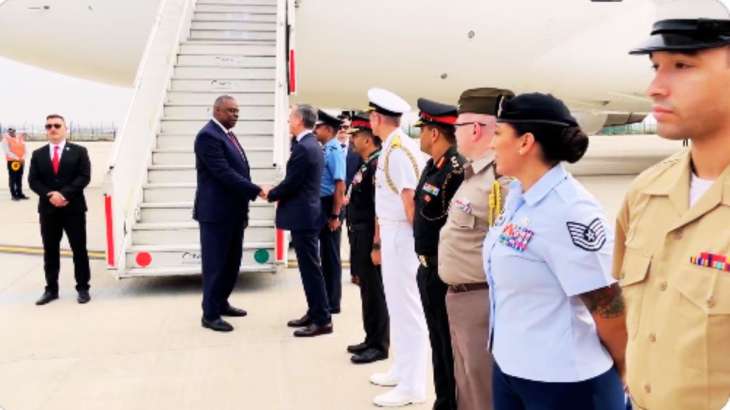
US Defense Secretary Lloyd Austin arrived in India on Sunday on a two-day visit to explore ways to further strengthen bilateral defense cooperation, especially in areas of transfer of key technologies for co-development of military hardware. Secretary Austin’s visit comes two weeks before Prime Minister Narendra Modi’s state visit to Washington, during which the two sides are expected to announce initiatives to expand the India-US Global Strategic Partnership.
The US Defense Secretary tweeted soon after landing in New Delhi, “I am returning to India to meet key leaders to discuss strengthening our key defense partnership. Together, we can build a free and open Indo-Pacific.” Advancing a shared vision for Delhi.
Austin will meet the Defense Minister
Defense Minister Rajnath Singh and Austin on Monday over General Electric’s proposal to share technology with India for fighter jet engines and New Delhi’s plan to buy 30 MQ-9B armed drones from the US Defense at a cost of over USD 3 billion Ready to discuss. Major General Atomics Aeronautical Systems Inc., among other issues, said people familiar with the matter.
India is looking to manufacture jet engines in India under the framework of transfer of technology to power its fighter aircraft. In June 2016, the US designated India a “Major Defense Partner”, paving the way for sharing of critical military equipment and technology.
Free Indo-Pacific will be the main agenda
China’s aggressive behavior along the Line of Actual Control and ways to deal with the threat of terrorism in the Indo-Pacific region are also likely to be discussed between Singh and Austin. US Defense Secretary arrived from Singapore. This is Secretary Austin’s second visit to India. His last visit to India was in March 2021.
In his address at the Shangri-La Dialogue in Singapore on Friday, the US Defense Secretary said, “Our initiatives with India on critical and emerging technology allow us to explore new ways to co-develop key defense platforms.”
Austin said the US is “planning, coordinating and increasing training with our friends from the East China Sea to the South China Sea to the Indian Ocean.”
“It includes staunch allies like Australia, Japan, the Republic of Korea, the Philippines and Thailand. And it also includes important partners like India, Indonesia, Vietnam and obviously our hosts here in Singapore today,” he said.
PM Modi and Biden announced iCET
In a major move, President Joe Biden and Prime Minister Modi in May last year announced the US-India Partnership on Critical and Emerging Technologies (ICET) to enhance and expand the strategic technology partnership and defense industrial cooperation between the two countries. Initiative. ICET is expected to establish closer ties between the government, academia and industry of the two countries in areas such as artificial intelligence, quantum computing, 5G and 6G, biotech, space and semiconductors.
Austin tweeted on Saturday that he was deeply saddened by the train accident in Balasore. “Deeply saddened to hear about the tragedy in Balasore. We stand with our colleagues in India. I will personally convey my condolences when I meet senior leaders in India in the coming days,” he said. Responding to the tweet, Singh said: “Deeply touched by your condolences. Thank you for your support. Looking forward to meeting you tomorrow.”
India-US defense and strategic ties have deepened in the last few years.
Indo-US Defense Relations
The two countries have entered into major defense and security agreements over the years, including the Logistics Exchange Memorandum of Agreement (LEMOA) in 2016, which allows their militaries to use each other’s bases for repair and replenishment of supplies. allows. The two sides also signed COMCASA (Communications Compatibility and Security Agreement) in 2018, which provides interoperability between the two militaries and the sale of high technology from the US to India. In October 2020, India and the US sealed the BECA (Basic Exchange and Cooperation Agreement) agreement to further boost bilateral defense ties. The agreement provides for sharing of high-end military technology, logistics and geospatial maps between the two countries.
(With inputs from PTI)
ALSO READ: ‘Confrontation with US would be intolerable disaster’: China seeks talks with Washington